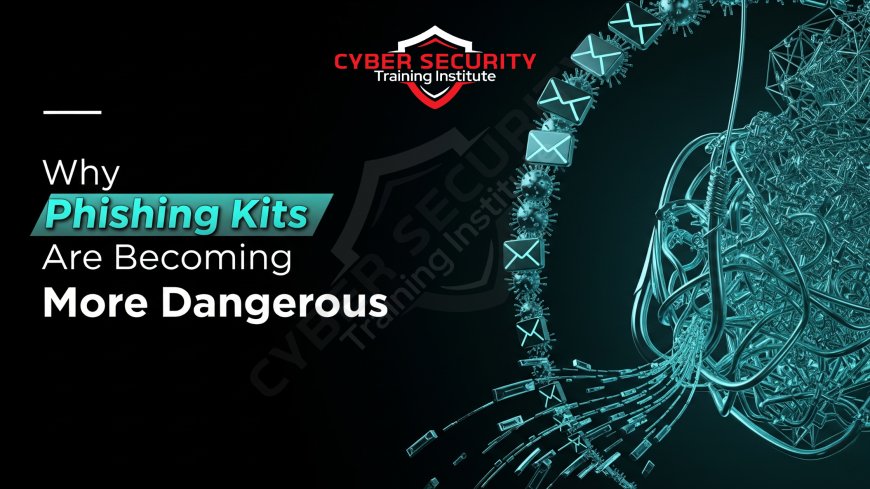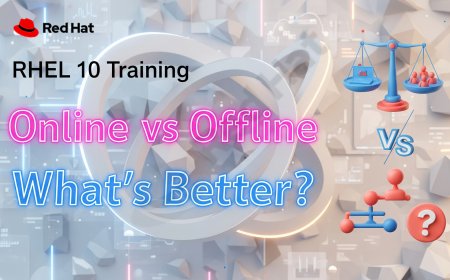Why Phishing Kits Are Becoming More Dangerous
The simple "scam in a box" has evolved into a sophisticated, full-featured attack platform. This in-depth article explains why the modern phishing kit has become one of the most dangerous tools in the cybercriminal's arsenal. We break down the revolutionary new features that are now standard in these kits, most importantly the integration of Adversary-in-the-Middle (AitM) reverse proxy technology, which allows even low-skilled attackers to bypass most common forms of Multi-Factor Authentication (MFA). Discover the advanced evasion techniques, like polymorphic code and bot detection, that these kits now use to hide from security scanners and researchers. The piece features a comparative analysis of the basic phishing kits of the past versus the advanced, feature-rich platforms of today, highlighting the shift to a user-friendly, subscription-based "Phishing-as-a-Service" (PhaaS) model. This is an essential read for any security professional or business leader who needs to understand how the industrialization of phishing has democratized advanced attacks and why a defense based on phishing-resistant authentication like Passkeys is now more critical than ever.

Introduction: The Scam in a Box Gets an Upgrade
Phishing has been the internet's most persistent plague for a simple reason: it works. The engine that has powered this epidemic for decades is the "phishing kit"—a pre-packaged, do-it-yourself toolkit that allows a low-skilled criminal to quickly and easily set up a malicious website and start stealing credentials. For a long time, these kits were simple and often clumsy. But today, they are evolving at an alarming rate. The humble phishing kit is no longer just a collection of stolen HTML code and images. It has transformed into a sophisticated, feature-rich attack platform. Phishing kits are becoming more dangerous because they are now incorporating advanced, real-time functionality to bypass Multi-Factor Authentication (MFA), dynamic content to evade security scanners, and are being sold in a user-friendly "as-a-service" model that makes high-level fraud accessible to almost anyone.
The Classic Phishing Kit: A Simple Forgery
To understand how dangerous the new kits are, we first need to look at the classic phishing kit that was common for years. A traditional kit was little more than a "scam in a box." It was typically a single `.zip` file that a criminal would buy on a dark web forum. This file contained:
- A set of HTML, CSS, and image files that were a direct, static copy of a real company's login page (for example, a bank or a webmail provider).
- A simple server-side script (usually written in PHP) that would take the username and password a victim entered into the fake form.
- A second script that would write these stolen credentials to a text file on the server and often email them directly to the attacker.
While effective against unsuspecting victims, these classic kits had major limitations. The websites they created were static, so they were very easy for security companies to find, create a "fingerprint" or signature of, and then automatically block. Most importantly, they were completely stopped by any form of Multi-Factor Authentication (MFA). If a user entered their password, the kit had no way to ask for or handle the second factor, like an OTP code.
The Game-Changer: Adversary-in-the-Middle (AitM) Kits
The single biggest and most dangerous evolution in modern phishing kits is the integration of Adversary-in-the-Middle (AitM) functionality. This technique completely changes the game and is the key to bypassing MFA.
An AitM phishing kit doesn't use a static, fake copy of a website. Instead, it acts as a real-time reverse proxy. The victim clicks a phishing link and is sent to the attacker's server, but that server then opens its own connection to the real, legitimate website. It acts as a bridge, or a "man in the middle," passing traffic back and forth. The website the victim sees looks and feels absolutely perfect—every button works, every link is correct—because it *is* the real website, just being mirrored through the attacker's proxy.
This is what allows the kit to defeat most forms of MFA. When the real site asks the user for their password and then their One-Time Password (OTP), those prompts are passed through the proxy to the victim. When the victim enters the correct credentials and the OTP, those are passed back to the real site, which then successfully logs them in. In that final step, the attacker's server is able to intercept and steal the "session cookie," the piece of data that keeps a user logged in. The attacker can then use this stolen session cookie to access the account, having completely bypassed the MFA. This feature, which is now a standard part of advanced phishing kits, makes it possible for even low-skilled criminals to defeat our most important security controls.
Evasion and Persistence: The Cat-and-Mouse Game
Modern phishing kits are also being built with a range of features that are specifically designed to make them harder for security researchers and automated scanners to detect and take down.
- Dynamic Content and Polymorphism: Many kits now use JavaScript to dynamically generate or alter the HTML code of the phishing page for each visitor. This creates a "polymorphic" website. By ensuring that the underlying code is never exactly the same twice, it makes it much more difficult for security tools to create a stable, reusable signature to automatically blacklist the site.
- Geolocation and Bot Detection: The kit can check the IP address of every visitor. If the IP address is known to belong to a security company, a web crawler from Google, or a known analysis sandbox, the kit can be configured to show them a completely harmless decoy page (like a simple blog or a rickroll). It will only show the real phishing page to a visitor who appears to be a genuine, everyday user from the targeted region. This makes it incredibly difficult for security teams to investigate and confirm that the site is malicious.
.
The "as-a-Service" Model: Making Hacking Easy
The final factor making these kits more dangerous is their business model. In the past, a criminal would have to buy a kit, find their own (often bulletproof) web hosting, set up the server, configure the PHP scripts, and manage the whole operation. This still required a baseline of technical skill.
Today, the most advanced kits are sold as a Phishing-as-a-Service (PhaaS) platform. A criminal no longer buys a zip file; they pay a monthly subscription fee. For this fee, they get access to a user-friendly, point-and-click web dashboard. From this dashboard, they can choose their target brand, select a pre-written email lure, and launch their campaign with a few clicks. The PhaaS provider handles all the complex backend infrastructure—the AitM proxies, the domain registration and rotation, and the collection of the stolen credentials. This is the ultimate "democratization" of phishing. It has lowered the barrier to entry so much that anyone, regardless of their technical ability, can now launch a sophisticated, MFA-bypassing phishing campaign.
Comparative Analysis: Basic vs. Modern Phishing Kits
The modern phishing kit is a world apart from the simple forgeries of the past, offering a level of sophistication that was once the domain of elite hacking groups.
| Feature | Basic Phishing Kit | Modern Advanced Phishing Kit |
|---|---|---|
| Core Technology | A static, offline copy of a website's HTML, paired with a simple script to capture credentials. | A real-time reverse proxy (Adversary-in-the-Middle) that perfectly mirrors the legitimate website's live content. |
| MFA Capability | None. Was completely stopped by any form of Multi-Factor Authentication. | Can successfully steal OTPs and, more importantly, session tokens, effectively bypassing most common forms of MFA. |
| Evasion Techniques | Was static and very easy for security scanners to fingerprint and blacklist. It had no built-in evasion. | Uses polymorphic code and integrated bot detection to actively hide from security scanners and researchers. |
| Business Model | Was typically a one-time purchase of a downloadable zip file. It required the user to perform a manual setup. | Is most often sold as a monthly subscription (PhaaS) with a user-friendly dashboard and full backend support from the provider. |
| Required User Skill | Required a user with at least some technical skill to set up and manage a web server and to configure the scripts. | Is designed for a completely non-technical user. It is a "point-and-click" attack tool. |
Conclusion: The New Era of Industrialized Phishing
The humble phishing kit has evolved from a simple copy-and-paste template into a sophisticated, feature-rich, and alarmingly user-friendly attack platform. The integration of Adversary-in-the-Middle technology for MFA bypass and the easy-to-use "as-a-service" subscription model are the two key developments that have made them so incredibly dangerous. This has led to a new era of industrialized phishing, where even the most advanced attacks can be launched by the least skilled criminals.
This new reality means that our defensive strategies must also evolve. We can no longer just rely on blacklisting bad websites, as the sites are now too dynamic. The defense must focus on the two endpoints of the attack that have not changed: the initial lure and the final authentication act. This means we need AI-powered email security that can understand the context of a message to spot a social engineering attempt, and, most importantly, we must accelerate the global adoption of truly phishing-resistant authentication standards like Passkeys, which are technically immune to the session hijacking that these advanced kits are designed to perform.
Frequently Asked Questions
What is a phishing kit?
A phishing kit is a pre-packaged set of tools and files that allows a criminal to quickly and easily set up a phishing website. It's a "scam in a box."
What is Phishing-as-a-Service (PhaaS)?
PhaaS is a criminal business model where developers sell access to a full-featured phishing platform for a monthly subscription fee. They handle all the technical backend, and the subscriber just launches the campaigns.
What is an Adversary-in-the-Middle (AitM) attack?
An AitM is an advanced phishing attack where the attacker's website acts as a real-time proxy to the real site, allowing them to intercept passwords, MFA codes, and session tokens.
How does an AitM kit bypass MFA?
It passes the legitimate MFA challenge from the real site to the victim. When the victim enters their OTP or approves the prompt, the kit passes that successful response back to the real site and then steals the session cookie that is generated.
What is a session cookie?
A session cookie is a small file that a website gives your browser after you log in. It keeps you authenticated. If an attacker steals it, they can access your account without needing your password or MFA.
What is a polymorphic website?
It's a technique where the underlying code of a phishing website is slightly changed for each visitor. This is an evasion tactic used to make it harder for security software to block the site based on a static signature.
Why are these new kits so dangerous?
Because they make highly sophisticated attacks, like MFA bypass, accessible to a huge number of low-skilled criminals through an easy-to-use, "as-a-service" model.
How can I protect myself from these attacks?
The best defense is to be extremely skeptical of all unsolicited links in emails and messages. More importantly, use phishing-resistant authentication like Passkeys wherever possible.
What are Passkeys?
Passkeys are a modern, phishing-resistant replacement for passwords. They use the biometrics on your device and public-key cryptography to log you in, and they are not vulnerable to AitM attacks.
How does a phishing kit use bot detection?
It uses it defensively. The kit will try to detect if a visitor is a security bot or a researcher. If it detects one, it will show them a harmless decoy page to hide the real phishing site and avoid being taken down.
What is a "reverse proxy"?
A reverse proxy is a server that sits in front of other servers and forwards client (e.g., user) requests to those servers. In an AitM attack, the attacker's server is a malicious reverse proxy.
What is a ".zip" file?
A .zip file is a common type of archive file that is used to compress one or more files into a single, smaller file for easier transfer. Old phishing kits were often distributed as .zip files.
What is a PHP script?
PHP is a popular server-side scripting language. The classic phishing kit used a simple PHP script on the web server to receive the username and password that a victim submitted in a form.
Where do criminals buy these kits?
They are sold and advertised on dark web forums and marketplaces, which are hidden parts of the internet that require special software to access.
What does "democratization" mean in this context?
It means that a capability that was once exclusive to a small group of high-skilled individuals (like bypassing MFA) has now been packaged into an easy-to-use tool that is accessible to a much wider, less-skilled population.
What is a "fingerprint" of a website?
A fingerprint is a unique signature, often created by calculating a hash of the website's HTML code. Security companies share these fingerprints to quickly block known phishing sites.
What is a "lure"?
The "lure" is the content of the phishing email or message that is designed to trick the victim into clicking the link.
Can my company's branding be used in a kit?
Yes. The most effective kits are designed to be templates that can be easily customized to perfectly impersonate any major brand, from a bank to a tech company to a government agency.
What is a "dark web"?
The dark web is a part of the internet that is not indexed by search engines and requires special software to access. It provides anonymity and is a major hub for criminal marketplaces.
What is the most effective defense against modern phishing kits?
While user training and advanced email security are important, the single most effective technical defense is the adoption of phishing-resistant authentication like FIDO2/Passkeys, as they are not vulnerable to the session hijacking that is the primary goal of an AitM kit.
What's Your Reaction?
 Like
0
Like
0
 Dislike
0
Dislike
0
 Love
0
Love
0
 Funny
0
Funny
0
 Angry
0
Angry
0
 Sad
0
Sad
0
 Wow
0
Wow
0















